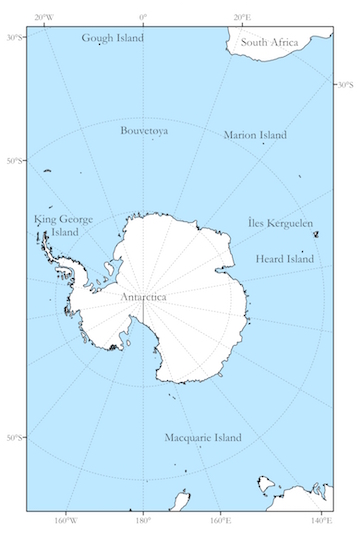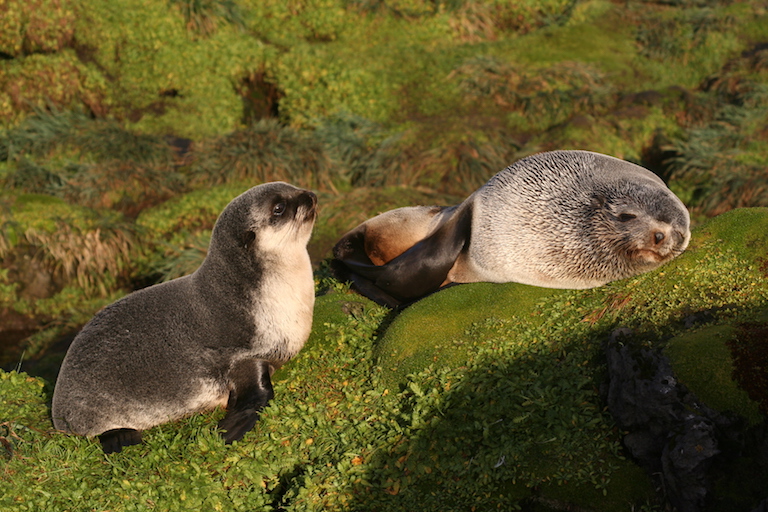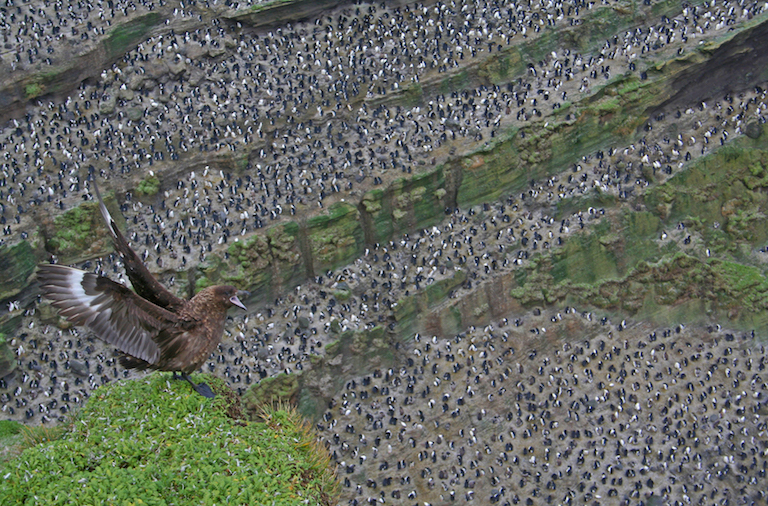- Sealers and subsequent human visitors to the Southern Ocean’s windswept islands brought with them a variety of invasive species, such as mice, rats, cats, sheep, and goats, that have wrought havoc on the islands’ native wildlife and ecosystems.
- On Marion Island, midway between South Africa and Antarctica, researchers and conservationists completed the largest successful cat eradication on an island in history in 1993.
- Marion Island’s wildlife has largely rebounded from the sealers and cats, but invasive mice continue to take a toll.
- The author points to other recent successful eradications of invasive species on Subantarctic islands and argues that they are a wise investment with benefits for wildlife as well as research into the region’s ecology and the effects of climate change. The views expressed are the author’s own, not necessarily Mongabay’s.
| The slideshow in this story contains an image that some readers may find disturbing. |
Forbidding black cliffs relentlessly shuddered by massive Southern Ocean waves give way to a mountainous interior, green but treeless, with a dusting of snow on the peaks. The coastal wall of cliffs is periodically broken by boulder-strewn beaches where thousands of penguins, fur seals, and elephant seals seem oblivious to the wind and cold. White spots on the green hillsides reveal the location of nesting albatrosses and the grey sky is filled with energetic petrels making their way to and from their mountain slope burrows. The vitality of the wildlife can easily lead a visitor to believe that Subantarctic Marion Island is a wild paradise unscathed by the human hand. Indeed, if not for a series of remarkable feats by scientists and conservationists, the wrongs of the past may well have stripped this island of that pristine aura for good.

Seal pelts and blubber, prized commodities during the late eighteenth, nineteenth, and twentieth centuries, sparked intriguing human histories on many Southern Ocean islands. People have made an accumulated impact on these islands, both intentional and at times by chance, as they exploited, explored, studied, or tried to undo past mistakes. The Prince Edward Islands archipelago, comprised of Marion Island and Prince Edward Island and situated approximately 2,300 kilometers (1,429 miles) southeast of Cape Town in the Roaring Forties, are no different.
It was the crew of the Maerseveen, a Dutch East Indiaman under the command of Barent Barentzoon Lam, who first discovered the islands in 1663, after the ship was blown off course. The ship’s company did not land and the islands continued undisturbed for more than a century. In 1772 Frenchman Marc-Joseph Marion du Fresne rediscovered them, but again inclement weather precluded a landing. During his third voyage of discovery in 1776, James Cook named the island group the “Prince Edward Islands.” The larger of the two islands later became known as Marion after the earlier French explorer, and the smaller confusingly retained the same name as the archipelago.
Even though they were unable to land, these early explorers noted the abundance of seals on the two islands. By around 1800 the first sealing gangs were probably working the islands. Their first confirmed presence is 1806, based on engravings on a rock on Prince Edward Island. Visits by sealers, initially for the skins of Subantarctic and Antarctic fur seals (Arctocephalus tropicalis and A. gazella) but soon also for the blubber oil of southern elephant seals (Mirounga leonina), continued through the nineteenth and early twentieth centuries.
By the time commercial harvesting of seals came to an end in 1930, the sealers had taken a heavy toll on the seal and some seabird populations. Data on the century-plus long seal harvest are scant. However, it must have been significant given that a diminishing harvest was cited as the reason for the cessation of sealing. Even so, the crew of the S.S. Kildalkey, in their final expedition in 1930, still slaughtered 1,490 elephant seals. Fur seals had probably been reduced to almost zero by 1930 according to South African biologist Bob Rand, who in 1951 noted only one small breeding rookery on Marion Island with around 200 animals.
But in addition to carting off marine mammals, the sealers also left Marion Island with an accidental unwelcome inheritance — invasive house mice (Mus musculus).

After World War II, global political and economic priorities related to the start of the Cold War and the value of whales increased the strategic importance of the Southern Ocean islands. South Africa annexed Marion Island and then Prince Edward Island around the turn of 1948. Since then, South African expeditioners — at first mainly meteorologists and logistics personnel; later an increasing proportion of scientists — have maintained a continuous year-round presence at a succession of base stations on Marion Island. During the early years, the mice became such a nuisance at the base station that the expeditioners thought it logical to bring something to the island that eats mice — cats.
It soon became evident that two wrongs do not make a right! The cats quickly multiplied and spread across Marion Island’s 300 square kilometers (116 square miles). By the mid-1970s the feral cat population had grown to an estimated 2,139 individuals, give or take, and was increasing at a rate of around 26 percent annually. By 1975 it was clear that the cats were taking a major toll on Marion’s bird life. (Just a few years earlier, at the 1962 Conference of the International Council for Bird Preservation, scientists had expressed concern that domestic and invasive animals may be negatively affecting avifauna on Subantarctic islands.) Each year the kitties were eating an estimated 450,000 of Marion Island’s various species of petrels (family Procellariidae). And they had already driven the common diving petrel (Pelecanoides urinatrix) locally extinct. Clearly, something had to be done.
Warning: this slideshow contains an image that some readers may find disturbing.
















A transparent, scientific, and well coordinated seven-phase cat eradication program commenced in the mid-1970s under the auspices of the South African Scientific Committee on Antarctic Research (SASCAR). Academics, biologists, and field personnel affiliated with the University of Pretoria’s Mammal Research Institute led the effort.
Following in-depth baseline scientific and feasibility studies, the first eradication phase commenced in 1977. The team released 96 cats innoculated with the deadly and highly infectious feline Panleucopaenia (“cat-flu”) virus into the island’s feral cat population, then estimated at 3,405.
As the cat population declined, the virus lost its infectious momentum and SASCAR turned to a new eradication measure: cat hunters. Between 1981 and 1991, this eclectic mix of men toted shotguns and spotlights over volcanic hill and boggy dale, through wind, rain, and snow mostly at night in search of cats. It was an almost unbelievable effort of determination and perseverance in hostile conditions. But slowly the number of shot cats accumulated. When monitoring showed that hunting wasn’t enough, baited traps and finally controlled poisoning drove the final nail into the cats’ coffin.
In 1993, after 19 years and at a cost of around $800 000, the team verified that not a single cat remained on Marion Island. Those in the know celebrated this unparalleled achievement, which remains the largest successful cat eradication on an island in history.
A number of academics had initially expressed skepticism that the Marion Island cat-eradication program would ever succeed. Members of the public opposed to the killing of cats doubted the humaneness of the methodology and denounced the program in the media. All this despite ample evidence that the cats were devastating the indigenous birdlife and the eradication program’s widely consultative processes, ethical approval by governmental, university, and veterinary councils, and its continuous monitoring of progress .

Nevertheless, in the end the program succeeded; cats no longer roamed Marion Island and within a decade many bird populations began to recover.
During the late 1970s and early 1980s, while the cat eradication was under way, mammalogists had begun studying Marion Island’s seal and killer whale (Orcinus orca) populations. By then, both fur seal species were well on their way to a remarkable recovery from hunting. (They produced thousands of pups on the archipelago in 2016.)
The island’s elephant seals seemed to have rebounded as well, initially, producing almost 4,000 pups on Marion Island annually around 1951. But by the time the mammalogists arrived on Marion the species, an important and widespread Southern Ocean predator, was suffering precipitous range-wide declines. In fact, on Marion Island the elephant seal population declined by more than 50 percent between 1951 and 1974.
In 1983, the mammologists, organized at first simply as the Pinniped Monitoring Programme but later as the Marion Island Marine Mammal Programme (MIMMP), part of the University of Pretoria, began an intensive flipper-tagging mark-recapture experiment that continues to this day. Although a hypothesis that the seals’ food sources were limited due to environmental conditions has received the most support, the causes of the decline remain unknown. The decline continued until around 1997, at which point the Marion Island population was down by almost 80 percent since 1951. Since then it has stabilized, and is now increasing slowly, with around 550 pups produced on Marion Island each year. The ongoing studies are teaching us a great deal about the demographic processes at work in this seal species, the health of the broader ecosystem, and how marine mammal populations in general are regulated and respond to environmental change.
Sealers (of the modern kind — who study rather than kill seals) and cat hunters were often the same individuals during the 1980s. The logistical skills, field experience, and background of these men — the first women sealers came on in 1999 — promoted cross-pollination of field activities in the early seal research years. Importantly, the arduous cat-eradication work also instilled a healthy work ethic for the seal research. And so the modern Marion sealer was born.

Over the past 34 years the MIMMP has grown beyond elephant seals and killer whales to encompass studies on the island’s Antarctic and Subantarctic fur seals. The program now includes movement, foraging, behavioral, molecular, and physiological approaches to the study of these species and their interactions with the changing environment. It has become one of the longest running, most intensive multi-species top marine mammal predator studies in the world and has provided advances in ecological theory as well as insights for conservation and management action for these species and their ecosystem.
One concrete outcome came in 2013 when South Africa proclaimed one of the largest marine protected areas in the world around the Prince Edward Islands archipelago. This was based in part on the MIMMP’s foraging analyses of seals from these islands. As Special Nature Reserves, the highest protective status under South African law, the Prince Edward Islands are strictly managed for research and conservation purposes only. Seal and killer whale populations are stable or increasing, while the 27 seabird species that nest at the islands show varied population trajectories. Research continues to unravel the causes and consequences of these trends.
Many threats to these top predator populations are linked to environmental changes or interactions with fisheries in remote foraging areas. But one insidious threat persists on Marion Island itself: the mice. Research over the years has illustrated the negative effects of these invaders on Marion Island’s vegetation and invertebrates. These studies have been facilitated by the fact that neighboring Prince Edward Island somehow escaped the fate of its larger sister island, in that it never received either mice or cats, and therefore provides a benchmark for their effects.
However, recent research at Marion Island is showing such blatantly devastating effects of mice that a benchmark is hardly needed. The mice are quite literally eating albatross (family Diomedeidae) and petrel chicks alive! Determining whether mice are causing observed declines in several seabird species on the island is currently a focus for other research programs, including teams from the Percy Fitzpatrick Institute for African Ornithology at the University of Cape Town.

We are once again at a crossroads and it seems clear that something has to be done. The cascading influence of human actions continues as we now look at techniques to eradicate the mice. But if the successes and scientific spin-offs of the controversial cat eradication are anything to go by, perhaps the immediate costs of getting rid of the mice will amount to but a fraction of the long-term dividends.
Indeed recent endeavours to rid other Subantarctic islands of pest species have been successful. An intensive seven-year, $19.1 million campaign, completed in 2014, successfully eradicated rats, rabbits, and mice from Australia’s 130 square kilometer (50 square mile) Macquarie Island. This was after an earlier cat eradication there, from 1984 to 2000. The British in 2015 completed what appears to be the largest successful eradication project in history by ridding the 1,050 square kilometer (405 square mile) South Georgia Island of rats at a cost of $9.7 million. Rare birds, such as the South Georgia pipit (Anthus antarcticus) are already recolonizing the island. Even large and permanently populated islands, such as New Zealand, are investing heavily in invasive species control to mitigate the ecological and economic damage caused by creatures like possums and weasels. The country is currently planning the most ambitious large-scale invasive mammal eradication ever.
These are wise investments. Numerous Subantarctic islands still have invasive species aplenty, including cats, rabbits, sheep, goats, and other animals, and their sensitive native ecosystems would benefit from determined eradication programs. Without the confounding effects of invasives, research on the indigenous fauna and flora of these islands will be able to tell us more about wider environmental and climatic changes of importance to humanity. Subantarctic islands, by virtue of their location within the major driver of global climate, the Southern Ocean, provide some of the most commanding opportunities to study the effects of global climate change on our world, and conserving their native ecosystems is central to that opportunity.
Professor P.J.N. (Nico) de Bruyn is the principal investigator of the University of Pretoria’s Marion Island Marine Mammal Programme (MIMMP). Pain Forms the Character, a recent book he co-edited about the human and natural history of Marion Island, is available on the MIMMP website, where information regarding how to work with or assist the program’s research is also available.

| Editor’s note 6/30/17: A previous version of this story omitted the final paragraph. It has now been fixed. |
